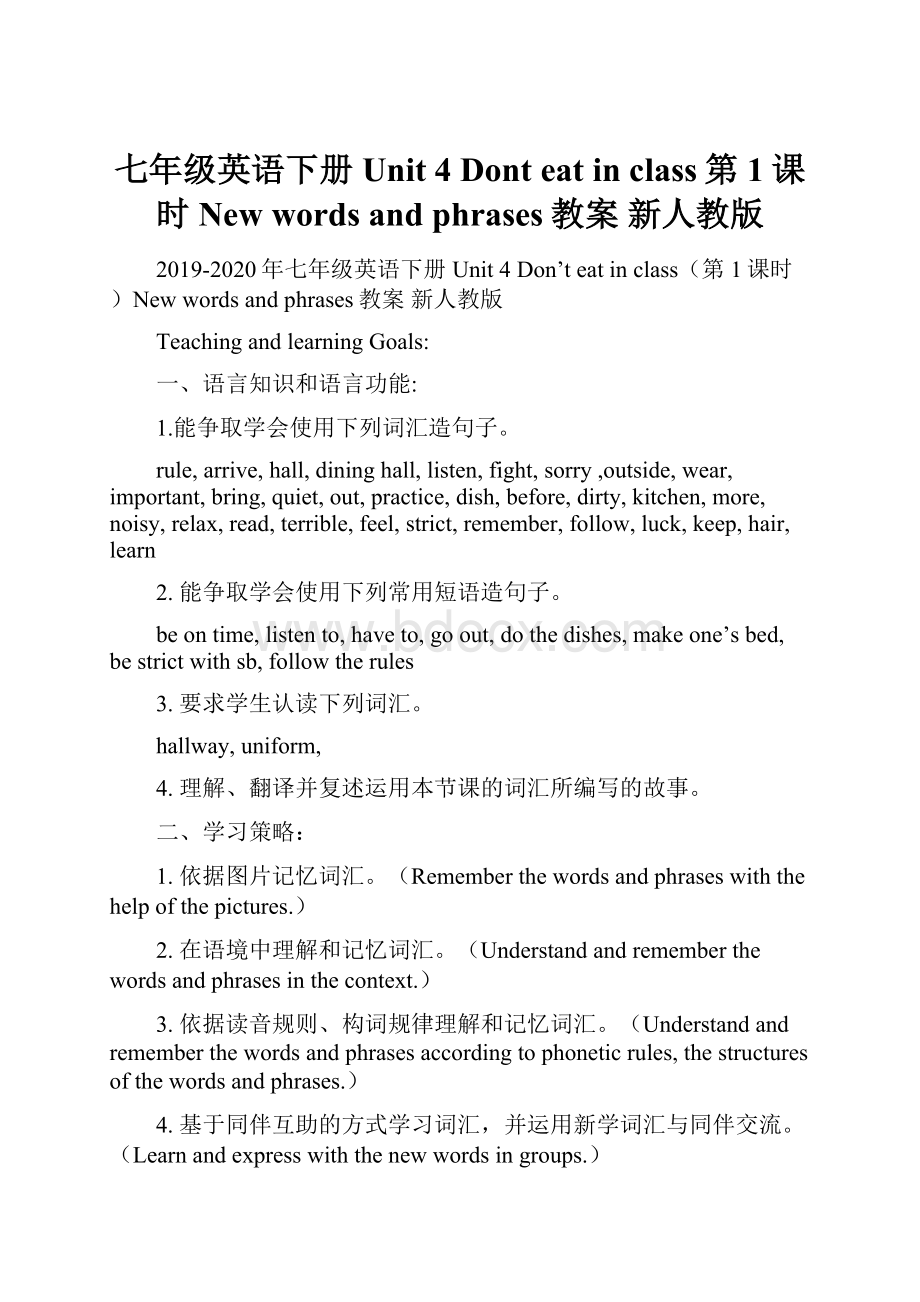 七年级英语下册 Unit 4 Dont eat in class第1课时New words and phrases教案 新人教版Word文档格式.docx
七年级英语下册 Unit 4 Dont eat in class第1课时New words and phrases教案 新人教版Word文档格式.docx
- 文档编号:22720624
- 上传时间:2023-02-05
- 格式:DOCX
- 页数:19
- 大小:1.08MB
七年级英语下册 Unit 4 Dont eat in class第1课时New words and phrases教案 新人教版Word文档格式.docx
《七年级英语下册 Unit 4 Dont eat in class第1课时New words and phrases教案 新人教版Word文档格式.docx》由会员分享,可在线阅读,更多相关《七年级英语下册 Unit 4 Dont eat in class第1课时New words and phrases教案 新人教版Word文档格式.docx(19页珍藏版)》请在冰豆网上搜索。

对于教师来说,不仅要传授学生知识,更要教学生如何做人。
Teachingandlearningsteps:
Step1.Warming-up.
Playaflashaboutthetrafficrulesandshowthewordrule.
rule[ru:
l]n.规则,规章
followtherules
Wehavetofollowtherulesatschool.
Wehavetofollowtherulesinschool.
【设计意图】通过一段有关交通规则的flash引出rule一词,并告诉学生本单元我们将学习不同地方的不同规则,守规矩才可以成为受欢迎的人。
Step2.LearnhowtoreadthenewwordsofUnit4.(P122-123)
1.First,readthenewwordsusingthephonetics(音标)andmark(标记)thewordsdifficulttopronounce(难发音的单词)inUnit4bythemselves..
2.Next,readthemarkedwordsinturninsmallgroups.Onestudentread,theotherslistenandhelptocorrectthewrongpronunciation(纠正错误发音).
3.Then,severalstudentsreadthewordsaloudinturninclassandtheotherscorrecttheirwrongpronunciations.
4.Next,playthetapeandasktheSstoreadafterthetapetocorrectthepronunciation.
5.Readthewordsaloudbyyourselvesagain.Theteacherwalksaroundthegroupstogivenecessaryhelp.
【设计意图】经过一个学期的学习,学生基本具备读音标识单词的能力,因此在读单词阶段,先让学生试读单词;
再通过跟读录音,让学生自我纠正一些不准确的发音;
最后通过小组互助和老师个别辅导的方式,使少部分拼读能力不强的同学,也能得到有针对性的帮助,争取人人过朗读关。
这一环节,主要是培养学生自主学习和小组互助学习的能力。
Step3.LearnhowtomemorizethenewwordsandphrasesonP122-123.
1.Rememberthewordsandphrasesaccordingtothepictures.
halln.大厅;
礼堂
Thisisaverybighall.
hallwayn.走廊,过道
Don’truninthehallways.
dininghall餐厅
Peopleofteneatinthedininghall.
dish[dɪʃ]n.碟;
盘
dishes
dothedishes
Wemustpracticedoingthedishes.
kitchen['
kɪtʃɪn]n.厨房
dirtykitchen
Dirtykitchenisterrible.
Don’tleavethedirtydishesinthekitchen.
hairn.头发
Shehaslonghair.
uniformn.校服;
制服
Wehavetoweartheschooluniformatschool.
relaxv.放松;
休息
Ioftenrelaxonweekends.
listento…听……
Sheislisteningtothemusic.
fightv.&
n.打架;
战斗
Don’tfight.
makeone’sbed铺床
Makeyourbedafteryougetup.
practicen.&
v.练习
practicetheguitar
arrivev.到达
arrivelateforclass
Don’tarrivelateforclass.Youmustbeontime.
【设计意图】图片直观形象,更能吸引学生兴趣,借助图片信息记住单词。
首先让学生根据图片猜测词汇.然后出示例句,再让学生猜测词意并记住例句。
这样学生易于接受、易于直观地理解单词的意思,印象深刻;
也易于促进理解、加深记忆。
这样既能培养学生用英语思维的习惯,也能减少学生对汉语的依赖,避免孤立地理解和记忆单词。
2.Rememberthewordsbyconversion(转换)、plexwords(合成)、derivative(派生)andparison(对比).
1.hall(大厅)+way(道路)→hallway
out(外面的)+side(边,面)→outside
2.luck→lucky
dirt→dirty
arriveat/insp.
3.“到达”reachsp.
gettosp.
4.noisyadj.quietadj.
where
5.同音词
wear
【设计意图】通过构词法学习单词,降低学生记忆的难度,提高学习英语的兴趣。
同时也能使学生举一反三,增加学生的词汇量。
3.Rememberthewordsaccordingtotheirsimilarpronunciations.(音标记忆法)
readfeelkeepea,ee,/i/
morebeforeore/ɔ:
/
importantuniformor/ɔ:
listendishstricti/i/
sorryfollowo/ɔ/
i
arrivefight/aɪ/
kitchenbring/i/
4.Rememberthewordsbychanting.
Goodstudentsmustfollowtherules.
Don’tarrivelateforclass.Don’tlistentomusicinclass.
Youmustbeontime.Youhavetowearauniform.
Don’tbenoisy.Keepquietinthelibrary.
Learntomakeourbeds,andcleanourhair.
Don’tfight,oryou’llnotthavegoodluck.
Remember,remember:
beingstrictisimportant.
【设计意图】说唱模式朗朗上口,学生好记也爱记,达到了学生在开心愉快的环境中学习的目的。
5.Rememberthewordsbydoingachallenge.
【设计意图】通过做游戏,提高学生的积极性,课堂气氛活跃,效果较好。
Step4.Consolidatethewordsandphrases
1.First,givethestudentsseveralminutestotrytomemorizethewords.
2.Next,askthemtolookattheChineseandsaytheEnglishwhilecoveringtheEnglishwordsandphrases.
3.Then,getstudentstoworkinpairstospellthewordsorwritedownthewordswiththeChinesegiveninguidebooks.Underlinethewordstheyhaven’tgrasped.
4.Finally,asktheSstowritedownthewordsandphrasestheyhaven’tgraspedontheirnotebooksforreviewingaftertheclass.
【设计意图】此环节为巩固单词。
通过朗读记忆,英汉互译检查,最后使用助学默写几种方式,对单词加以巩固。
这一环节有少部分的学生不能当堂达标,需要利用自习课或课余的时间让小组长跟踪检查,老师督促,达到人人过关。
Step5.ReadthestoryandtranslateintoChinese,thenlearnhowtousethenewwordsandphrasesinastory.
Inourschool,studentshavetofollowtherules:
Don’tarrivelateforclass.Beontimeisveryimportant.Don’truninthehallways
.Don’teatinclass.Studentscaneatinthedininghall
.Don’tfight
.Don’tlistentomusicinclass.Theycanlistenoutside.Onschooldays,studentshavetoweartheuniforms
.Andonschoolnights,studentscan’tgoout.Whentheyreadinthelibrary,theymustkeepquiet.Don’tbenoisy.Somestudentsfeelterribleaboutthem.Theythinkthey’retoostrict.I’mverysorrytohearthat.Becausethey’rehelpfulforthem.
What’smore,Ihopetheycanlearntomaketheirbed
dothedishes
athome.Don’tleaveadirtykitchen.Don’tkeephairlong
.Practicingtheguitar
beforegotobedcanrelax
.Remember,thesecanbringgoodluck.
1.TranslatethestoryintoChineseingroupsoftwo.
2.Readthestoryfluentlybythemselves.
3.Getthestudentstoretellthestoryusingthepicturesorthefollowingsemanticmap.
【设计意图】
词不离句,句不离文。
词汇教学应采用词—句—文的教学模式,让学生将单词用到句子和语篇中,让学生在具体的语境中,体会单词和短语的意义;
复述故事环节采取两种方式,分为两个层次。
吃力的学生可以选择根据图片和提示复述,有能力的学生可以选择根据思维导图来复述。
StepV.Exercises:
theend-of-classtest.(当堂检测)
一、根据提示写单词。
1.Thereareeight_______(规则)intheschool.
2.Julialikesto_________(听)tomusicverymuch.
3.It’snotrightto________(打架)withyourfriend.
4.Itiscold__________(外面).Let’sgointotheroom.
5.Wehavetobe__________(安静的)inthelibrary.
二、完成句子。
1.Myfatheroften__________________________(清洗餐具)afterdinner.
2.Wecan’t_____________(出去)onschoolnights.
3.Don’tleavethedirtydishes_______________________(在厨房里).
4.Ihaveto___________________________(遵守规则)atschool.
5.Mymother_____________________________________(对我要求严格)athome.
【设计意图】设计不同形式的练习题,进一步巩固所学单词,同时检测学生的学习情况,有助于以学定教。
StepVI.Homework
1.AsktheSstoreviewthewordsandphrasesinUnit4.(★)
2.PreviewSectionA1a-2d.(★★)
3.Ifyoucan:
Makesentencesusingthenewvocabularyinbold.(★★★)
【设计意图】采用分层作业的形式。
作业一是复习课本基础词汇,要求中等学生和后进生完成。
作业二是能力的拓展,要求学生能造句子,中上等学生完成。
作业三是用四会词汇编故事,这是学生能力的进一步提升,要求优秀生完成。
本节课的亮点:
1.
通过不同形式让学生学习,记住并运用单词,让单词放在具体语境中运用,达到学以致用目的,争取课堂上能让更多的学生掌握所学,减轻课下学习的负担。
2.积极调动每个学生的学习热情,参与课堂,体验学习的乐趣,感受成功带来的自信。
3.思维导图和短文有机结合,对所学单词从整体上达到巩固效果。
4.家庭作业分层布置,让能力不同的同学,做更能体现他们各自水平的作业。
不足之处:
一节课的时间毕竟有限,不能面面俱到,还需在以后的复习中查缺补漏和加大检查的广度。
使用建议:
1.首先,要熟练掌握本单元教学内容,明确单词词组在单元中的位置及其用法;
同时注意两人或多人小组合作或帮扶学习的方式使用,加大检查普及率,增大学生合作学习活动的广度、力度,才能有效地增加课堂效率。
2.其次,教师课前准备要充分,使用多媒体或一体机教学,提高课堂效率。
3.最后,当堂检测要求学生同位互批,错题小组讨论解决,体现学生的互助合作精神。
参考答案:
StepV.当堂检测
Answers:
一、1.rules2.listen3.fight4.outside5.quiet
二、1.doesthedishes2.goout3.inthekitchen4.followtherules5.isstrictwithme
2019-2020年七年级英语下册Unit4ElectricityLanguage教案牛津广州版
课题
Unit4.Electricity
Language
课时
第4课时
教学目标
1.了解情态动词can,may,must的基本用法;
2.掌握情态动词在肯定句、否定句和疑问句中的结构。
重点和难点
1.让学生学会掌握情态动词can,may,must的基本用法;
2.能够用情态动词纠正人们使用电器时的不正确之处;
3.知道can与may的区别,mustnot与neednot的区别。
教
学
过
程
Step1.Warming-up
1.Letthestudentsfindoutthesentenceswhichcontainmodalverbsinthetext,forexample:
1)Canyougetmeapacketofelectricity,please?
2)Youcan’tbuyelectricityinpacketslikesweets!
3)MayIhavemypacketofelectricity?
4)Whenyoulookatapicture,yourbrainholdsthepictureforone-tenthofasecond,thenyoumustlookagain.
Step2.
1.Letthestudentstranslatethefollowingmodalverbs:
1).can能、会、能够
2).cannot=can’t不能
3).can’tbe不可能是
4).may可以
5).maybe也许是
6).maynot可以不
7).must必须
8).mustbe一定是
9).mustnot=mustn’t禁止,不许
10).neednot=needn’t不必要
2.FinishexercisesofA1,BandC,thencheckingtheanswerstogether.
Step3.
1.Explainhowtousethemodalverbs:
can:
a表示能力,中文意思是“__能;
会”,相当于_beableto。
b.表示许可,中文意思是“_可以_”,相当于may。
c.表示可能性,can’t中文意思是“_不可能_”。
d.can的否定形式是_can’t__。
过去式_could__的语气比can更加客气委婉,表示语气时并不代表过去时。
may:
a.表示允许,中文意思是“__可以___”相当于_can/could_。
b.表示猜测,暗含的可能性较小,中文意思是“__也许__”。
c.may的否定式为__maynot__.注意may的否定式不能缩写。
且由may构成的一般疑问句的否定回答用__can’t或mustn’t_,而不用maynot。
must:
a.表示义务,中文意思是“__必须___”。
b.mustn’t的中文意思是“__禁止___”。
c.表推测,暗含有很大的可能性,用于肯定句,中文
意思是“__一定是___”。
d.注意:
由must构成的一般疑问句的否定回答要用needn’t_或_don’thavetodo_,而不用mustn’t。
f.must与haveto的区别,must表示主观看法,haveto表示客观需求,中文意思为__不得不__。
Step4.
Homeworkassignment.
教学反思
- 配套讲稿:
如PPT文件的首页显示word图标,表示该PPT已包含配套word讲稿。双击word图标可打开word文档。
- 特殊限制:
部分文档作品中含有的国旗、国徽等图片,仅作为作品整体效果示例展示,禁止商用。设计者仅对作品中独创性部分享有著作权。
- 关 键 词:
- 七年级英语下册 Unit Dont eat in class第1课时New words and phrases教案 新人教版 年级 英语 下册 class 课时 New phrases 教案 新人
 冰豆网所有资源均是用户自行上传分享,仅供网友学习交流,未经上传用户书面授权,请勿作他用。
冰豆网所有资源均是用户自行上传分享,仅供网友学习交流,未经上传用户书面授权,请勿作他用。
链接地址:https://www.bdocx.com/doc/22720624.html


 《JAVA编程基础》课程标准软件16级.docx
《JAVA编程基础》课程标准软件16级.docx
